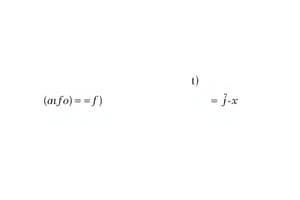Podcast
Questions and Answers
Which statement accurately defines a function?
Which statement accurately defines a function?
- A function can have multiple outputs for a single input.
- A function is defined as any pairing of input and output values.
- A function can include inputs that are not paired with any outputs.
- A function pairs each input value with exactly one output value. (correct)
What distinguishes a one-to-one function from a many-to-one function?
What distinguishes a one-to-one function from a many-to-one function?
- A one-to-one function has multiple inputs mapping to the same output.
- A many-to-one function has horizontal lines that can intersect the graph in zero points.
- A one-to-one function has at least one output that corresponds to multiple inputs.
- In a one-to-one function, the output corresponds to only one input for every value. (correct)
Which type of function is characterized by a graph that forms a parabola?
Which type of function is characterized by a graph that forms a parabola?
- Rational function
- Polynomial function
- Linear function
- Quadratic function (correct)
What does the notation f(x) signify in function notation?
What does the notation f(x) signify in function notation?
In the context of graphing functions, what does finding intercepts refer to?
In the context of graphing functions, what does finding intercepts refer to?
What is necessary for a function to be invertible?
What is necessary for a function to be invertible?
What is a defining characteristic of a rational function?
What is a defining characteristic of a rational function?
In a mapping diagram for relations, what is typically represented?
In a mapping diagram for relations, what is typically represented?
Flashcards
Relation
Relation
A set of ordered pairs, showing a general pairing between input and output values.
Function
Function
A special relation where each input has exactly one output.
One-to-one function
One-to-one function
Each output corresponds to only one input.
Many-to-one function
Many-to-one function
Signup and view all the flashcards
Linear function
Linear function
Signup and view all the flashcards
Inverse function
Inverse function
Signup and view all the flashcards
Function notation
Function notation
Signup and view all the flashcards
Function Invertibility
Function Invertibility
Signup and view all the flashcards
Study Notes
Relation and Function
- A relation is a set of ordered pairs. It's a general pairing between input and output values.
- A function is a special type of relation where each input value (x-coordinate) is paired with exactly one output value (y-coordinate). No input has two or more outputs. This is the defining characteristic of a function.
Types of Relations
- Ordered pairs: A set of pairs (x, y) where x represents input and y represents output.
- Mapping diagrams: Show how inputs are mapped to outputs.
- Graphs: Visual representations of the relation on a coordinate plane.
- Sets of data: Tabular displays of input-output values.
Types of Functions
- One-to-one function: Each output (y-value) corresponds to exactly one input (x-value). A horizontal line drawn across the graph will intersect it at at most one point.
- Many-to-one function: Multiple input values (x-values) can map to the same output value (y-value). A horizontal line drawn across the graph can intersect multiple points, but each vertical line intersects at most one point.
- Onto function (surjective function): Range of function equals the codomain. Every element in the output set is mapped to by at least one input.
- Into function (not surjective function): Range of function is a proper subset of the codomain. Not every element in the output is necessarily mapped to.
- Linear function: A function whose graph forms a straight line. The most common type of function.
- Quadratic function: A function where the greatest power of x is 2; its graph is a parabola.
- Polynomial functions: Functions involving polynomials with any power.
- Rational function: Ratio of two polynomial functions.
Graphing Functions
- Cartesian coordinate system: Used to plot points and graph functions. The x-axis and y-axis intersect at the origin (0,0).
- Plotting points: Mark the ordered pairs on the graph.
- Interpreting graphs: Look for trends and relationships between x and y values.
- Finding intercepts: Where the graph crosses the x and y axes (x-intercepts and y-intercepts).
Inverse Functions
- Inverse functions "undo" one another. The inverse of a function f(x) is denoted as f-1(x).
- To obtain the inverse, typically we swap x and y and solve for y.
- Check for invertibility: To be invertible, the original function must be one-to-one.
Function Notation
- f(x) represents the output of a function f for a given input x.
- Example: If f(x) = 2x + 1, then f(3) = 2(3) + 1 = 7.
- Domain: Set of all possible input values (x-values).
- Range: Set of all possible output values (y-values).
- Codomain: The set of all possible output values the function could potentially produce, including those not actually included in the range.
Studying That Suits You
Use AI to generate personalized quizzes and flashcards to suit your learning preferences.




